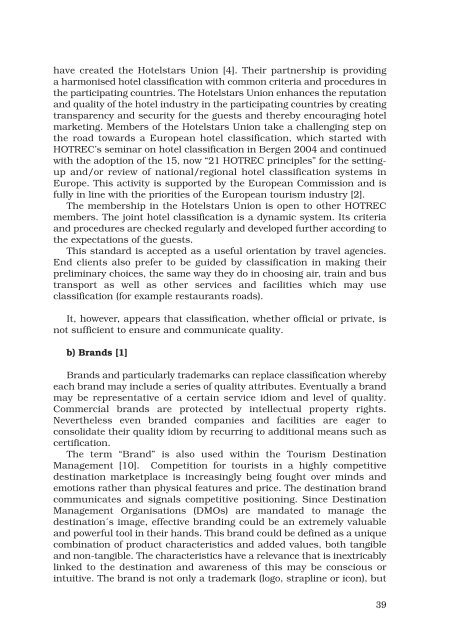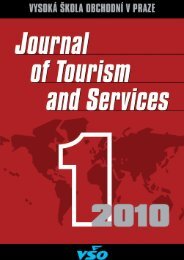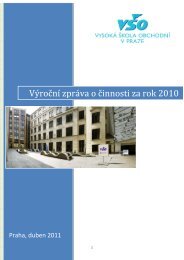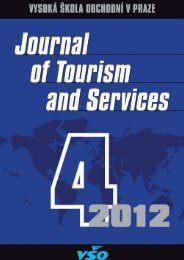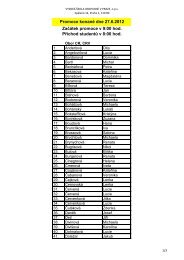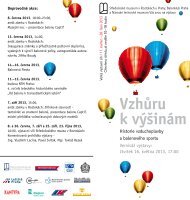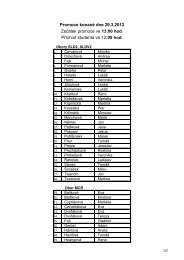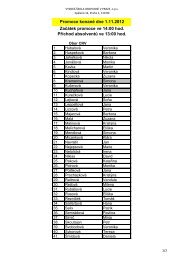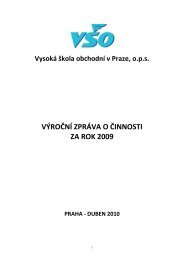Sestava 1 - Vysoká škola obchodnà v Praze
Sestava 1 - Vysoká škola obchodnà v Praze
Sestava 1 - Vysoká škola obchodnà v Praze
You also want an ePaper? Increase the reach of your titles
YUMPU automatically turns print PDFs into web optimized ePapers that Google loves.
have created the Hotelstars Union [4]. Their partnership is providing<br />
a harmonised hotel classification with common criteria and procedures in<br />
the participating countries. The Hotelstars Union enhances the reputation<br />
and quality of the hotel industry in the participating countries by creating<br />
transparency and security for the guests and thereby encouraging hotel<br />
marketing. Members of the Hotelstars Union take a challenging step on<br />
the road towards a European hotel classification, which started with<br />
HOTREC’s seminar on hotel classification in Bergen 2004 and continued<br />
with the adoption of the 15, now “21 HOTREC principles” for the settingup<br />
and/or review of national/regional hotel classification systems in<br />
Europe. This activity is supported by the European Commission and is<br />
fully in line with the priorities of the European tourism industry [2].<br />
The membership in the Hotelstars Union is open to other HOTREC<br />
members. The joint hotel classification is a dynamic system. Its criteria<br />
and procedures are checked regularly and developed further according to<br />
the expectations of the guests.<br />
This standard is accepted as a useful orientation by travel agencies.<br />
End clients also prefer to be guided by classification in making their<br />
preliminary choices, the same way they do in choosing air, train and bus<br />
transport as well as other services and facilities which may use<br />
classification (for example restaurants roads).<br />
It, however, appears that classification, whether official or private, is<br />
not sufficient to ensure and communicate quality.<br />
b) Brands [1]<br />
Brands and particularly trademarks can replace classification whereby<br />
each brand may include a series of quality attributes. Eventually a brand<br />
may be representative of a certain service idiom and level of quality.<br />
Commercial brands are protected by intellectual property rights.<br />
Nevertheless even branded companies and facilities are eager to<br />
consolidate their quality idiom by recurring to additional means such as<br />
certification.<br />
The term “Brand” is also used within the Tourism Destination<br />
Management [10]. Competition for tourists in a highly competitive<br />
destination marketplace is increasingly being fought over minds and<br />
emotions rather than physical features and price. The destination brand<br />
communicates and signals competitive positioning. Since Destination<br />
Management Organisations (DMOs) are mandated to manage the<br />
destination´s image, effective branding could be an extremely valuable<br />
and powerful tool in their hands. This brand could be defined as a unique<br />
combination of product characteristics and added values, both tangible<br />
and non-tangible. The characteristics have a relevance that is inextricably<br />
linked to the destination and awareness of this may be conscious or<br />
intuitive. The brand is not only a trademark (logo, strapline or icon), but<br />
39


